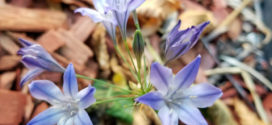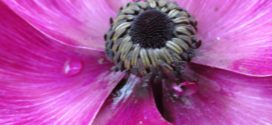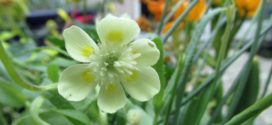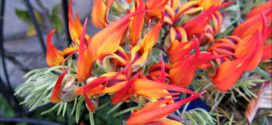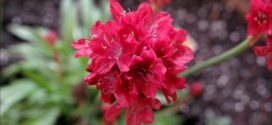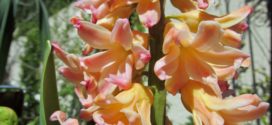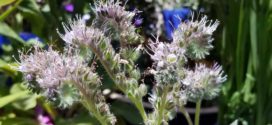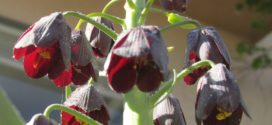Brodiaea laxa is commonly known as the triplet lily, grassnut lily, or wild hyacinth. This perennial bulb is a native wildflower to California, growing wild in evergreen woodlands. Locally, it is found in places like Edgewood Preserve on the San Mateo County peninsula and Almaden Quicksilver County Park. Grass-like leaves appear first, followed by clusters of light blue blossoms reaching …
Read More »Tag Archives: Spring
This Sunnyvale Garden – April 2017
April is always a great time in our Sunnyvale garden. The last few rain showers end by mid April. The spring bulbs finish their blossoms as the vines start blooming and the summer bulbs start peeking out from the ground. The tomato plants are already 2-3 feet tall and have blossoms. The citrus trees (orange, tangerine, grapefruit, lemon, lime) attracted …
Read More »Icelandic Poppy 2017
Iceland poppies are hardy but short-lived perennials, often grown as biennials, that yield large, papery, bowl-shaped, lightly fragrant flowers supported by hairy, one foot, curved stems among feathery blue-green foliage 1-6 inches long. This year’s crop was planted in our former fire-pit surrounded by cool-weather cyclamen and english daisy. They bloom in April after the crocus, hyacinth, and tulips. Iceland …
Read More »California Creamcup
Beauty in a small package: California Creamcup , has a one inch wide flower with six petals which may be pure white or golden or white with large gold spots or gold tips. The center of the flower is filled with a tuftlike cluster of many thick, flattened stamens. The small plant (12×18 inches) may produce hundreds of blossoms. The …
Read More »This Sunnyvale Garden – March 2017
We had average March weather in our Sunnyvale garden: about 8 days of rain but less in volume than February. We still had a lot of flowers: Pea-shrub, orinthogalum, several types of crocus, daffodils, tulips, hyacinths, freesia, armeria, plum, apricot, flowering plum, viola, cyclamen, english daisy, yarrow, bacopa, lavendar. On the vegetable side: cilantro, tomatoes, beet, garlic, rhubarb, chile, basil. …
Read More »Armeria maritima
Another first in 2017 for our Sunnyvale garden: Sea pink. Armeria maritima, commonly called thrift or sea pink, is a compact, low-growing plant which forms a dense, mounded tuft of stiff, linear, grass-like, dark green leaves (to 4″ tall). Tufts will spread slowly to 8-12″ wide. Tiny, pink to white flowers bloom in mid spring in globular clusters (3/4-1″ wide) …
Read More »Lotus Berthelotti – ‘Red Embers’
The stunning, brightly colored unusually shaped blooms of the evergreen trailing plant Lotus berthelotii, commonly called parrot’s beak, brings a tropical feel to your garden or landscape. Native to the Canary and Cape Verde Islands off the west coast of Africa, Parrot’s beak is a sun-loving perennial that can be grown as an annual in areas below U.S. Department of …
Read More »Hyacinth – Dutch
We grow hyacinth in our Sunnyvale garden most years. Attractive to bees, butterflies and/or birds. Flowers are fragrant. This plant is suitable for growing indoors. The Dutch Hyacinth does best if planted new every year. Hyacinth blooms the first week in March, after the crocus have finished blooming, and right before the tulips start blooming. In 2019 we planted Deep …
Read More »Phacelia californica
Phacelia californica (California scorpionweed) is a central California native. This herbaceous perennial grows to 1-2 feet tall. Plant in rock gardens or on a slope with good drainage. The common name is because the flowers unfurling from the stalk look like a scorpion’s tail. Less imaginative explanation: it is similar to ferns. The flowers provide an important nectar source for …
Read More »Persian Fritillary
Spikes of deep maroon bells create an intriguing focal point in the spring garden. The tall stems are clothed with gray-green leaves, which are attractive in their own right. The Persian fritillary usually requires a season or two to establish itself. There are about 100 to 130 species of bulbous plants in the family Liliaceae, native to temperate regions of …
Read More »